外研版(2019)高中英语必修第三册 Unit5 What an adventure Understanding ideas 优质课件(共46张PPT)
文档属性
| 名称 | 外研版(2019)高中英语必修第三册 Unit5 What an adventure Understanding ideas 优质课件(共46张PPT) |  | |
| 格式 | pptx | ||
| 文件大小 | 20.9MB | ||
| 资源类型 | 教案 | ||
| 版本资源 | 外研版(2019) | ||
| 科目 | 英语 | ||
| 更新时间 | 2023-03-01 17:08:14 | ||
图片预览

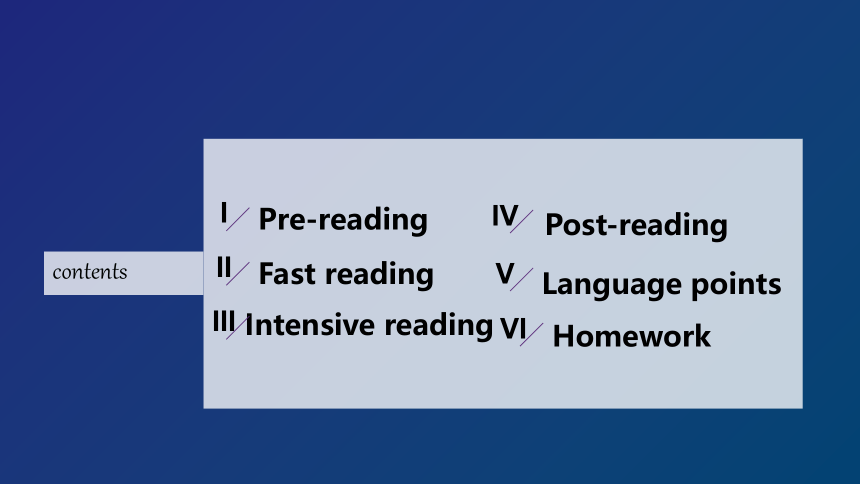
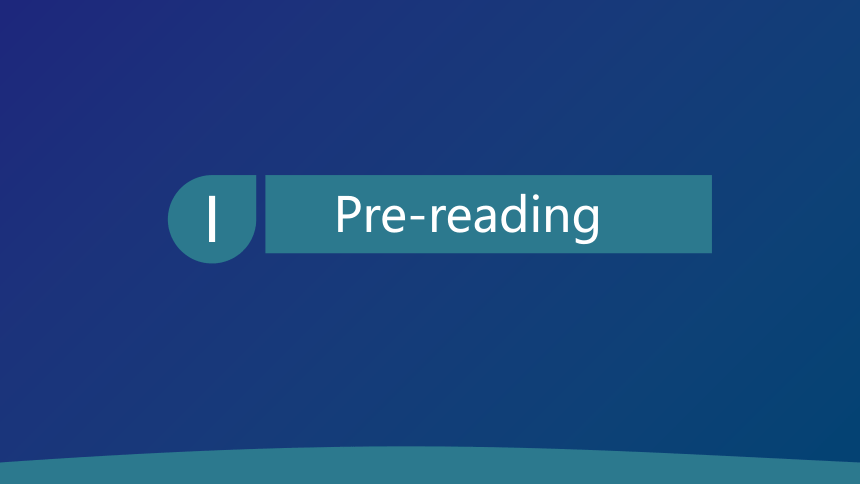


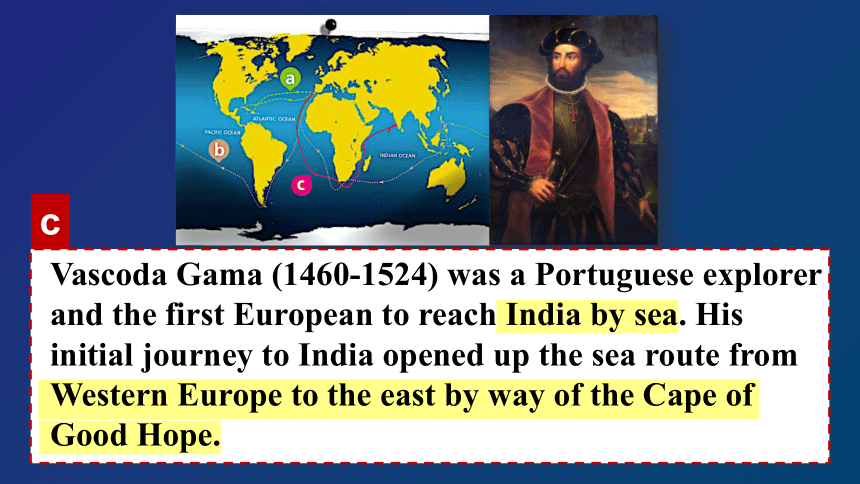

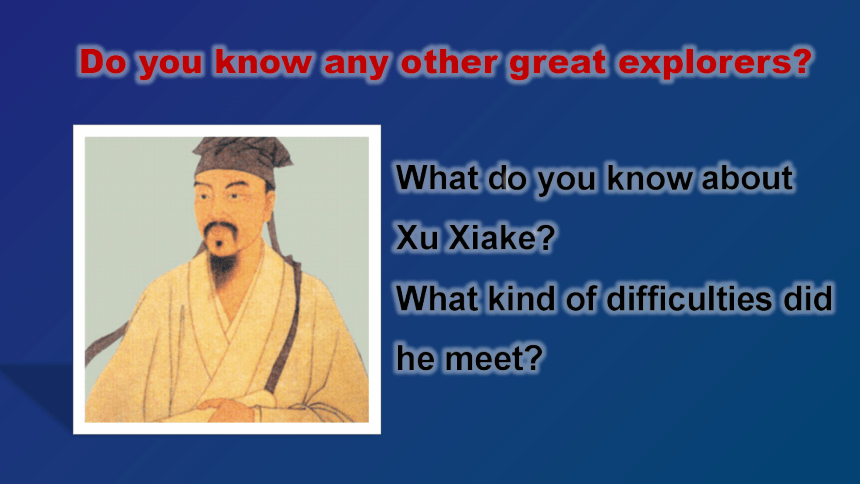
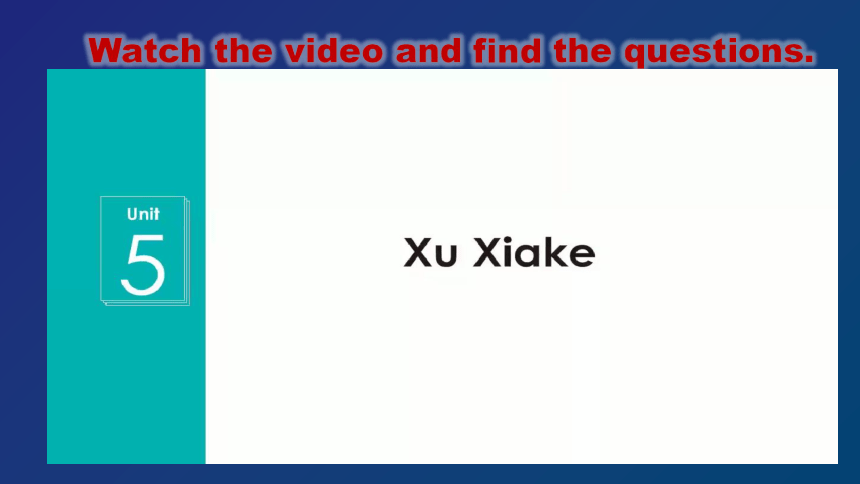
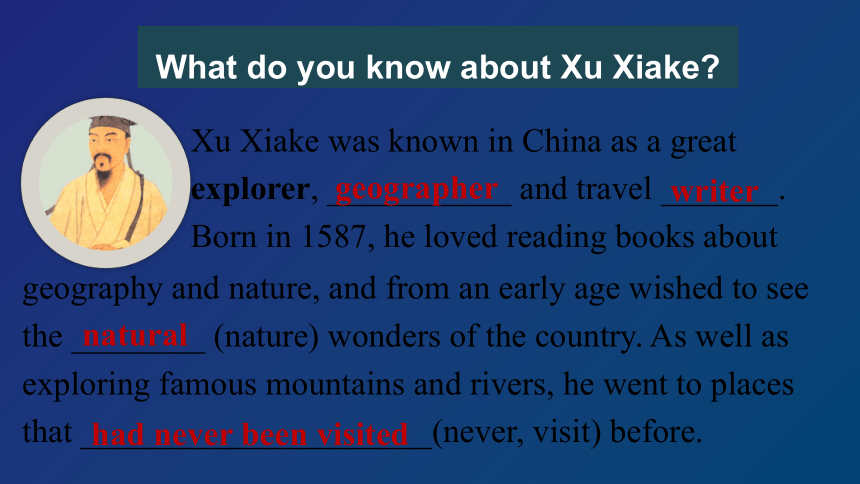
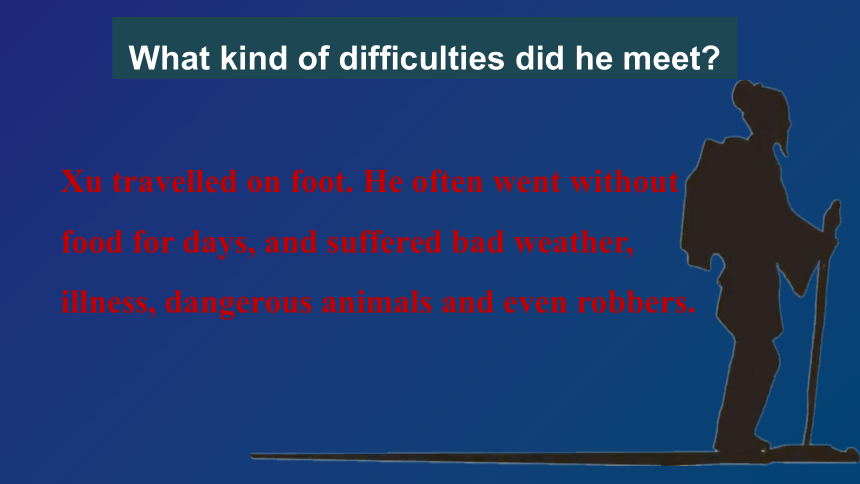
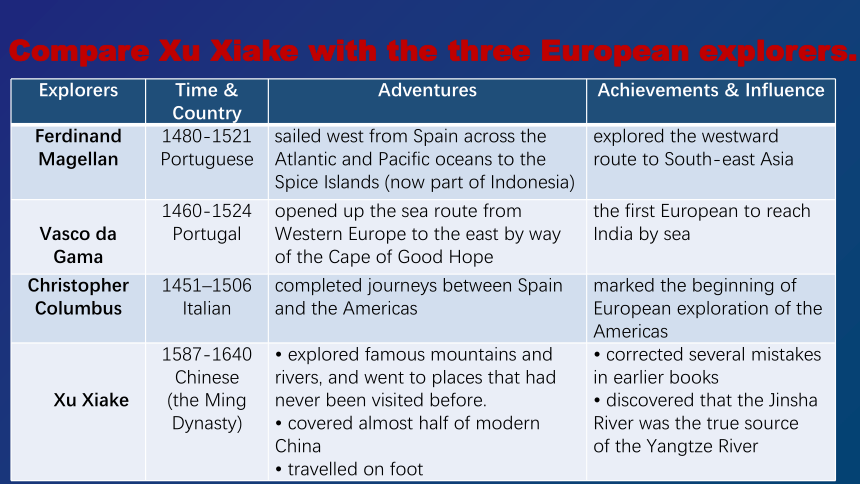
文档简介
(共46张PPT)
Unit 5 What an adventure!
Understanding ideas
【版本:外研 册别:必修三】
Pre-reading
I
Language points
IV
Fast reading
II
Homework
V
Intensive reading
III
VI
Post-reading
contents
I
Pre-reading
Look at the map, and read the information about the three explorers. Match the routes to the explorers. (P49)
b
Ferdinand Magellan (1480-1521) was a Portuguese explorer who sailed west from Spain across the Atlantic and Pacific oceans in search of a westward route to the Spice Islands (now part of Indonesia).
c
Vascoda Gama (1460-1524) was a Portuguese explorer and the first European to reach India by sea. His initial journey to India opened up the sea route from Western Europe to the east by way of the Cape of Good Hope.
a
Christopher Columbus (1451–1506) was an Italian explorer who completed journeys between Spain and the Americas, thus marking the beginning of European exploration of the Americas.
Do you know any other great explorers
What do you know about
Xu Xiake
What kind of difficulties did
he meet
Watch the video and find the questions.
Xu Xiake was known in China as a great explorer, ___________ and travel _______. Born in 1587, he loved reading books about
What do you know about Xu Xiake
geographer
writer
geography and nature, and from an early age wished to see the ________ (nature) wonders of the country. As well as exploring famous mountains and rivers, he went to places that _____________________(never, visit) before.
natural
had never been visited
What kind of difficulties did he meet
Xu travelled on foot. He often went without food for days, and suffered bad weather, illness, dangerous animals and even robbers.
Explorers Time & Country Adventures Achievements & Influence
Ferdinand Magellan 1480-1521 Portuguese sailed west from Spain across the Atlantic and Pacific oceans to the Spice Islands (now part of Indonesia) explored the westward
route to South-east Asia
Vasco da Gama 1460-1524 Portugal opened up the sea route from Western Europe to the east by way of the Cape of Good Hope the first European to reach
India by sea
Christopher Columbus 1451–1506 Italian completed journeys between Spain and the Americas marked the beginning of
European exploration of the
Americas
Xu Xiake 1587-1640 Chinese (the Ming Dynasty) explored famous mountains and rivers, and went to places that had never been visited before. covered almost half of modern China travelled on foot corrected several mistakes
in earlier books
discovered that the Jinsha
River was the true source
of the Yangtze River
Compare Xu Xiake with the three European explorers.
Look at the map (P50) and answer the questions.
1.Who were the first people confirmed
to have reached the top of the
mountain When did this happen
2. Why do you think the climbers need
so many camps along the route
3. What else do you know about
Qomolanqma
Look at the map (P50) and answer the questions.
1.Who were the first people confirmed to have reached
the top of the mountain When did this happen
Edmund Hillary and Tenzing Norgay.
In 1953.
Look at the map (P50) and answer the questions.
2. Why do you think the climbers need so many camps
along the route
It is such a long way that it cannot be done within one day. The climbers need these camps for a rest and adapt themselves to the environment.
Look at the map (P50) and answer the questions.
3. What else do you know about Qomolanqma
Qomolangma is the world’s highest mountain, located at the border between China and Nepal. In 2005, China remeasured the rock height of the mountain, with a result of 8844.43 m. Qomolangma attracts many climbers, and some of them are highly experienced mountaineers. There are two main climbing routes, one approaching the summit from the south-east in Nepal (known as the "standard route") and the other from the north in China's Tibet.
Read the passage and learn more about Qomolangma (P50-51)
II
Fast reading
CLIMBING
QOMOLANGMA: WORTH THE RISKS
What “Type T” personalities are
What’s the author’s purpose of writing the passage
What’s the organization of the passage
Read and Find
Read and Find
What “Type T” personalities are
“Type T” personalities, with the “T” standing for “thrill”, are personality traits that make people more likely to take risks than others.
Read and Find
What’s the author’s purpose of writing the passage
To encourage people to climb Qomolangma if fully prepared, as risks bring many benefits.
To remind people to balance the benefits and risks before deciding to climb Qomolangma.
To suggest that people stop taking risks and climbing Qomolangma, as the risks outweigh the benefits.
Read and Find
What’s the organization of the passage
Part Ⅰ (Para. _____) Introduction of the topic
Part Ⅱ (Para. _____) Reasons for the climbers’ risk-taking
Part Ⅲ (Para.______) Conclusion
1
2-6
7
III
Intensive reading
Complete the paragraphs with expressions from the passage.
(P52)
George Mallory
What people get from this adventure is just 1__________. People eat and make money to be able to 2 __________ , not the other way round.
sheer joy
enjoy life
Alan Arnette
Each person has a(n)3 ____________________ reason for climbing a mountain. It forces people to 4 _______ __________ themselves. To succeed, people must have the physical as well as 5 ____________________.
important and unique
look
deep inside
mental toughness
Scientific reasons
Risk-taking may be part of 6 _____________. People who are more likely to 7 __________ have “Type T” personalities. Research also suggests that our desire to seek risks can be connected to how much we expect to 8_____________________.
human nature
take risks
benefit from the result
Summary
Climbing Qomolangma: worth the risks
Introduction of the topic
Para 1
__________________________________
Climbing Qomolangma is a special experience.
Reasons for the climbers’ risk-taking
Scientific reasons
Subjective reasons
Para 2 : George Mallory:_____________________
Para 3: AlanArnette: It forces people to look inside themselves and figure out _______________________________________
just pure joy; enjoy life
if they really have the physical and mental toughness.
Para 4–5: perhaps part of human nature:_______________
Para 6:____________________________________________
“Type T” personalities
man’s desire to expect to benefit from the result
Conclusion
Para 7: It’s up to the readers to decide
__________________________________.
whether it is worth the risks to climb Qomolangma
IV
Post-reading
Do you agree with Mallory’s and Arnette’s
opinions Why
Think Share
Yes. Because I believe exploration is not only an exploration of nature and the unknown world, but also a challenge to oneself. That's a good chance to get improved. So I think if I am fully prepared, the benefits and joy the exploration brings to me outweigh the risks.
Language points
Ⅴ
Important words
personality
personal
personally
n. 个性;人格
adj. 个人的;私人的
adv. 个别地;就个人而言
英译汉
The novel is written from personal experience.
这部小说是根据个人的亲身经历而写的。
She has a very strong personality.
她个性很强。
Personally, I prefer to work in a team.
就我个人而言,我更喜欢在团队里工作。
吸烟与肺癌有关。
我写此信是想谈一谈你找工作的事。
I’m writing to you in connection with your job application.
There is a connection between smoking and lung cancer.
A USB port is a place where you can connect other machines to a computer.
USB端口是将其他设备连接到电脑的地方。
英译汉
Important words
connect v. (使)结合; (使)组合
connect ... to / with / and ...
connection
in connection with
Internet connection
把……与……连接起来
关于;与……有关
n. 接头;联系;关系
互联网连接
Important lexical chunks
hundreds of
low air pressure
sheer joy
succeed in reaching
majority of
成百上千
低气压
纯粹的快乐
成功到达……
大多数
figure out 明白,理解;计算出
It forces you to look deep inside yourself and figure out if you really have the physical, as well as mental, toughness to push when you want to stop.
Important sentences
过了好一会儿我才明白发生了什么。
It took me a while to figure out what happened.
It would be difficult to figure out the losses at this time.
现在还很难计算出有多少损失。
2. He refers to the personalities of these people as “Type T”, with the “T” standing for “thrill”.
refer to … as 称呼……为;把……称作
He likes to be referred to as “Doctor Khee”.
他喜欢别人叫他Khee医生。
Important sentences
Her expression suggested that she was angry.
3. Research also suggests that our desire to seek risks
can be connected to how much we expect to benefit
from the result.
她的表情说明她生气了。
suggest that …“表明(显示)……”(宾语从句)
Important sentences
VI
Homework
If you were given the chance, would you like to climb Qomolangma Why or why not Write your opinions.
Thanks
Unit 5 What an adventure!
Understanding ideas
【版本:外研 册别:必修三】
Pre-reading
I
Language points
IV
Fast reading
II
Homework
V
Intensive reading
III
VI
Post-reading
contents
I
Pre-reading
Look at the map, and read the information about the three explorers. Match the routes to the explorers. (P49)
b
Ferdinand Magellan (1480-1521) was a Portuguese explorer who sailed west from Spain across the Atlantic and Pacific oceans in search of a westward route to the Spice Islands (now part of Indonesia).
c
Vascoda Gama (1460-1524) was a Portuguese explorer and the first European to reach India by sea. His initial journey to India opened up the sea route from Western Europe to the east by way of the Cape of Good Hope.
a
Christopher Columbus (1451–1506) was an Italian explorer who completed journeys between Spain and the Americas, thus marking the beginning of European exploration of the Americas.
Do you know any other great explorers
What do you know about
Xu Xiake
What kind of difficulties did
he meet
Watch the video and find the questions.
Xu Xiake was known in China as a great explorer, ___________ and travel _______. Born in 1587, he loved reading books about
What do you know about Xu Xiake
geographer
writer
geography and nature, and from an early age wished to see the ________ (nature) wonders of the country. As well as exploring famous mountains and rivers, he went to places that _____________________(never, visit) before.
natural
had never been visited
What kind of difficulties did he meet
Xu travelled on foot. He often went without food for days, and suffered bad weather, illness, dangerous animals and even robbers.
Explorers Time & Country Adventures Achievements & Influence
Ferdinand Magellan 1480-1521 Portuguese sailed west from Spain across the Atlantic and Pacific oceans to the Spice Islands (now part of Indonesia) explored the westward
route to South-east Asia
Vasco da Gama 1460-1524 Portugal opened up the sea route from Western Europe to the east by way of the Cape of Good Hope the first European to reach
India by sea
Christopher Columbus 1451–1506 Italian completed journeys between Spain and the Americas marked the beginning of
European exploration of the
Americas
Xu Xiake 1587-1640 Chinese (the Ming Dynasty) explored famous mountains and rivers, and went to places that had never been visited before. covered almost half of modern China travelled on foot corrected several mistakes
in earlier books
discovered that the Jinsha
River was the true source
of the Yangtze River
Compare Xu Xiake with the three European explorers.
Look at the map (P50) and answer the questions.
1.Who were the first people confirmed
to have reached the top of the
mountain When did this happen
2. Why do you think the climbers need
so many camps along the route
3. What else do you know about
Qomolanqma
Look at the map (P50) and answer the questions.
1.Who were the first people confirmed to have reached
the top of the mountain When did this happen
Edmund Hillary and Tenzing Norgay.
In 1953.
Look at the map (P50) and answer the questions.
2. Why do you think the climbers need so many camps
along the route
It is such a long way that it cannot be done within one day. The climbers need these camps for a rest and adapt themselves to the environment.
Look at the map (P50) and answer the questions.
3. What else do you know about Qomolanqma
Qomolangma is the world’s highest mountain, located at the border between China and Nepal. In 2005, China remeasured the rock height of the mountain, with a result of 8844.43 m. Qomolangma attracts many climbers, and some of them are highly experienced mountaineers. There are two main climbing routes, one approaching the summit from the south-east in Nepal (known as the "standard route") and the other from the north in China's Tibet.
Read the passage and learn more about Qomolangma (P50-51)
II
Fast reading
CLIMBING
QOMOLANGMA: WORTH THE RISKS
What “Type T” personalities are
What’s the author’s purpose of writing the passage
What’s the organization of the passage
Read and Find
Read and Find
What “Type T” personalities are
“Type T” personalities, with the “T” standing for “thrill”, are personality traits that make people more likely to take risks than others.
Read and Find
What’s the author’s purpose of writing the passage
To encourage people to climb Qomolangma if fully prepared, as risks bring many benefits.
To remind people to balance the benefits and risks before deciding to climb Qomolangma.
To suggest that people stop taking risks and climbing Qomolangma, as the risks outweigh the benefits.
Read and Find
What’s the organization of the passage
Part Ⅰ (Para. _____) Introduction of the topic
Part Ⅱ (Para. _____) Reasons for the climbers’ risk-taking
Part Ⅲ (Para.______) Conclusion
1
2-6
7
III
Intensive reading
Complete the paragraphs with expressions from the passage.
(P52)
George Mallory
What people get from this adventure is just 1__________. People eat and make money to be able to 2 __________ , not the other way round.
sheer joy
enjoy life
Alan Arnette
Each person has a(n)3 ____________________ reason for climbing a mountain. It forces people to 4 _______ __________ themselves. To succeed, people must have the physical as well as 5 ____________________.
important and unique
look
deep inside
mental toughness
Scientific reasons
Risk-taking may be part of 6 _____________. People who are more likely to 7 __________ have “Type T” personalities. Research also suggests that our desire to seek risks can be connected to how much we expect to 8_____________________.
human nature
take risks
benefit from the result
Summary
Climbing Qomolangma: worth the risks
Introduction of the topic
Para 1
__________________________________
Climbing Qomolangma is a special experience.
Reasons for the climbers’ risk-taking
Scientific reasons
Subjective reasons
Para 2 : George Mallory:_____________________
Para 3: AlanArnette: It forces people to look inside themselves and figure out _______________________________________
just pure joy; enjoy life
if they really have the physical and mental toughness.
Para 4–5: perhaps part of human nature:_______________
Para 6:____________________________________________
“Type T” personalities
man’s desire to expect to benefit from the result
Conclusion
Para 7: It’s up to the readers to decide
__________________________________.
whether it is worth the risks to climb Qomolangma
IV
Post-reading
Do you agree with Mallory’s and Arnette’s
opinions Why
Think Share
Yes. Because I believe exploration is not only an exploration of nature and the unknown world, but also a challenge to oneself. That's a good chance to get improved. So I think if I am fully prepared, the benefits and joy the exploration brings to me outweigh the risks.
Language points
Ⅴ
Important words
personality
personal
personally
n. 个性;人格
adj. 个人的;私人的
adv. 个别地;就个人而言
英译汉
The novel is written from personal experience.
这部小说是根据个人的亲身经历而写的。
She has a very strong personality.
她个性很强。
Personally, I prefer to work in a team.
就我个人而言,我更喜欢在团队里工作。
吸烟与肺癌有关。
我写此信是想谈一谈你找工作的事。
I’m writing to you in connection with your job application.
There is a connection between smoking and lung cancer.
A USB port is a place where you can connect other machines to a computer.
USB端口是将其他设备连接到电脑的地方。
英译汉
Important words
connect v. (使)结合; (使)组合
connect ... to / with / and ...
connection
in connection with
Internet connection
把……与……连接起来
关于;与……有关
n. 接头;联系;关系
互联网连接
Important lexical chunks
hundreds of
low air pressure
sheer joy
succeed in reaching
majority of
成百上千
低气压
纯粹的快乐
成功到达……
大多数
figure out 明白,理解;计算出
It forces you to look deep inside yourself and figure out if you really have the physical, as well as mental, toughness to push when you want to stop.
Important sentences
过了好一会儿我才明白发生了什么。
It took me a while to figure out what happened.
It would be difficult to figure out the losses at this time.
现在还很难计算出有多少损失。
2. He refers to the personalities of these people as “Type T”, with the “T” standing for “thrill”.
refer to … as 称呼……为;把……称作
He likes to be referred to as “Doctor Khee”.
他喜欢别人叫他Khee医生。
Important sentences
Her expression suggested that she was angry.
3. Research also suggests that our desire to seek risks
can be connected to how much we expect to benefit
from the result.
她的表情说明她生气了。
suggest that …“表明(显示)……”(宾语从句)
Important sentences
VI
Homework
If you were given the chance, would you like to climb Qomolangma Why or why not Write your opinions.
Thanks
